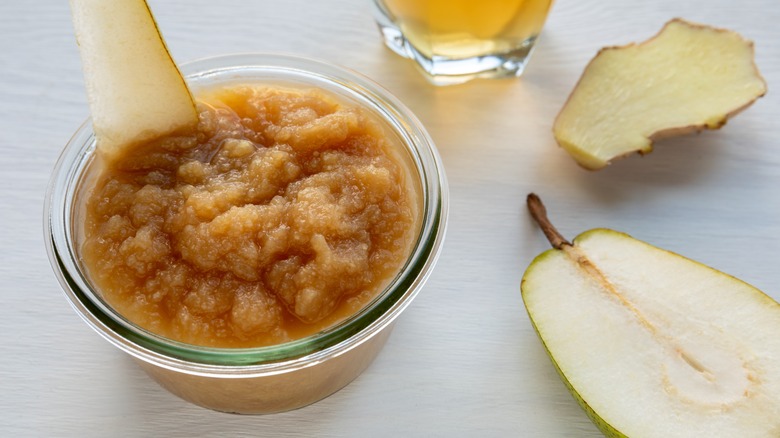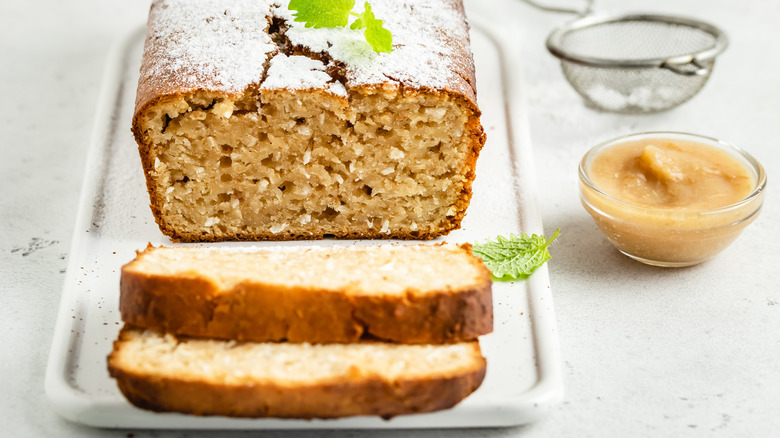Pear Sauce Is The Baking Oil Substitute We Never Knew We Needed
If you're searching for how to bake healthy desserts, turn your eyes to pear sauce. (Yes, it's just like applesauce but made from pears.) Wherever a baking recipe calls for liquid oil, this fruity purée can take its place, cup for cup. That includes vegetable oil, canola oil, and even melted butter.
The most obvious nutritional benefit of this swap is the reduction in fat and total calories. For example, 100 grams of vegetable oil will contribute 94 grams of fat and about 850 calories to your recipe, whereas the equivalent of pear boasts less than 100 calories and virtually no fat. You'll also enjoy the boost of fiber and antioxidants that elevates pears' status over oil. Plus, research has linked pear consumption with reduced risks for heart disease and diabetes. We're not seeing a downside so far.
Besides the fat reduction, another reason you'd want to use pear sauce in baking is when you've purchased pears and they're starting to soften — fast. Like avocados, pears are notorious for going from rocks to mush in an instant. Instead of tossing them in the compost, stew them up for a delicious and nutritious baking ingredient.
How does pear sauce replace oil?
The primary role of oil in baking is as a moisturizer. At over 80% water, pears and their purée will certainly add moisture to your baking, yet the final product's perceived moistness might be a bit less. That's because more of the water-based moisture in the pear sauce will evaporate during cooking, whereas the fat-based moisture in oil does not.
In most baked goods, you'll be using wheat-based flour, which contains the components for the protein gluten. Even though gluten is a controversial ingredient, it's crucial for products' chewiness and structure. It's also an important determinant of baked goods' tenderness (or lack thereof). Generally speaking, oil prevents gluten formation while water promotes it. Therefore, water-based pear sauce can result in a firmer, chewier texture compared to the more delicate consistency that results from using baking oil.
For first-time pear sauce bakers, substitute a quarter to a half of the recipe's oil with the purée, then observe the changes in texture and mouthfeel. Consider how sturdy you'd want your final product to be before making a complete switch, as this can result in a cakey, yet dense muffin or brownie.
Pear sauce vs. applesauce as an oil substitute
You've probably heard that applesauce can also replace oil in baking. Now you can take standard commercial applesauce (or most homemade applesauce recipes) and swap in the equivalent of pear sauce. The flavor will be similarly mild, whereas other low-fat oil substitutes (like mashed bananas or pumpkin) impart a distinct flavor that may not jive with your recipe. In terms of consistency and moisture content, the two are pretty evenly matched as well, although sensitive palates may notice the slight graininess of the pear variation.
And not to point out the obvious here, but applesauce is much easier to find at the grocery store when compared with pear sauce. For the latter, your best bet is the baby food section, where the unit price is usually much higher than adult versions of the same food. On the other hand, you probably need less than a cup of the stuff for a recipe anyway, so the higher unit cost may be worth the convenience of popping open a tiny container just when you need it. That way, you're avoiding any potential food waste.
To recap: Pear sauce offers a lower-fat alternative to oil that imparts moistness while also strengthening the structure of baked goods. If your baked good could benefit from a bit more sturdiness, then pear sauce may be just the thing.


